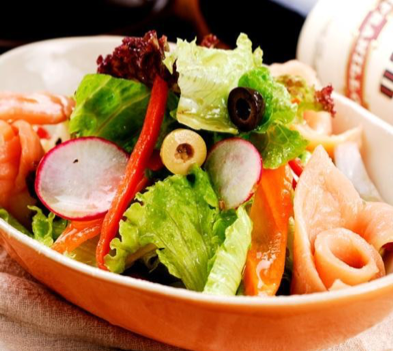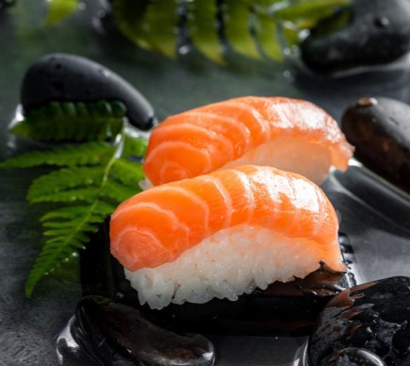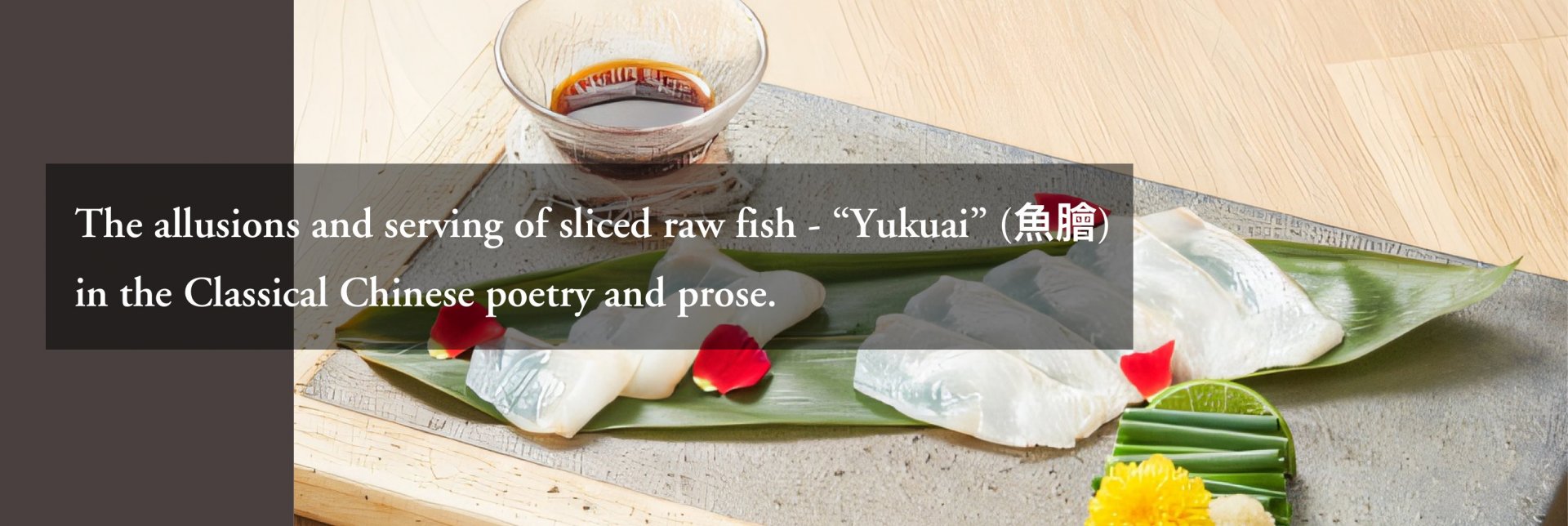The allusions and serving of sliced raw fish - “Yukuai” in the Classical Chinese poetry and prose
“Yukuai” (魚膾) is the sliced raw fish, which we commonly call it “Sashimi”. The definition of “Yukuai” was found in the chapter Shaoyi of The Book of Rites (《禮記·少儀》) , it recorded that “to slice the fresh beef, mutton and fish and cut them into small pieces, it becomes “Kuai” (膾, meat cut into small pieces)”.1 As early in the Pre-Qin period, there were having different documents to record the custom of people eating sliced raw fish at that time. The Book of Songs (《詩經》) recorded when it was in the Zhou Dynasty, the General Yin Jifu (尹吉甫,852-775 B.C.) brought his army and conquered Xian Yun (玁狁), and made a great achievement to the imperial court. The army supporting officer Zhang Zhong (張仲,?-?) and other comrades were invited to attend the celebration feast. The main dishes were the grilled soft-shelled turtle and fresh carp fillet.2 In The Analects (《論語》), The Book of Etiquette and Ceremonial (《儀禮》) and The Book of Rites (《禮記》), the three books recorded the serving of the sliced raw fish during the Spring and Autumn Period.3 The fish was sliced as thin as the cicada’s wings, and the people ate it with mustard sauce and green onions. The mustard here is not the wasabi. It was made with mashed mustard seeds. It is sieved finely, cooked for several times to remove the bitter taste and stir it with low heat to become the mustard sauce.4 During the Wei Jin Southern and Northern dynasty, people became more concerned about the taste of sliced raw fish with sauce. In the book Qi Min Yao Shu (《齊民要術》), it recorded the method of making another sauce, which called as Baheji (八和齏). It made with eight ingredients, including garlic, ginger, tangerine, white plum, cooked chestnuts, japonica rice, salt and vinegar.5 The process of making this sauce was complicated because it was to reduce the stimulating tastes such as bitter, spicy and sour, and to highlight the fragrance of tangerine and the sweet taste of chestnuts. The favour became to have more layers, meticulous and harmonious with surprises. The tangerine peels made the dish more refreshing, adding extra aroma and sweetness. When the tangerine peels were added to the sliced raw fish which was oily and fresh, the dish was magnificent as gold and the sliced raw fish was thin and crystal clear. The Tang citizens liked to enjoy the sliced raw fish in this way very much. Li Qunyu (李群玉,?-862) wrote the poem Serving the Dongyangtan Stone Carp in the Shimen Weiming Mansion (〈石門韋明府為致東陽潭石鯽鱠〉). In his poem, he wrote the tangerines added freshness and taste to the sliced raw fish (「更劳霜橘助芳鲜」). Wang Changling (王昌齡,698-755) wrote Farewell Cheng Liu (《送程六》). He recorded that he had a dish with his friend which was sliced raw fish with tangerine sauce (「青鱼雪落鲙橙虀」). They praised the sliced raw fish was as crystal clear as the snow and frost and the sauce was tasty. People used the water shield as a side dish to the sliced raw fish. The water shield is the new leaf of the lotus that has been sunk in the water and has not yet unfolded. The leaves were wrapped in transparent mucus, it has a smooth texture and a fresh taste. In the book Qi Min Yao Shu pointed out that the people chose the water shield as their first choice of ingredients to make the vegetable soup.6 This soup should be added with the sliced raw fish, seasoned with black bean and salt, so the dish complements the fish's fresh, sweet and tender taste. It was a famous dish in Wuzhong (吳中) area (now near Jiangsu and Zhejiang). In the Southern Dynasty, the book Shi Shuo Xin Yu (《世説新語》) recorded that when Zhang Han (張翰,?-?) was an official in Luoyang, he missed the Wuzhong's water shield soup and the sliced sea bass, which made him got to realize that he should enjoy his life instead of leaving his hometown for the sake of fame and fortune. He resigned from his position and travelled back to his hometown.7 From the above stories, we can see the dish of sliced raw fish with water shield were the perfect match, and its unique delicacy stimulated the homesickness of the wanderers.

Sliced Raw fish with tangerine
In the Tang Dynasty, eating sliced raw fish became popular at that time. According to the Gong Ci (〈宮詞〉) written by Madame Huarui Consort Xu (花蕊夫人徐氏,?-976), she reflected that she was fascinated by the freshness and fatness of the sliced raw fish, and she repeatedly urged the fishermen to offer the fresh sliced raw fish for her to enjoy.8 The royal enjoyed eating the sliced raw fish, and the peasants followed them and became obsessed with eating the sliced raw fish too. The famous poets of the Tang Dynasty, such as Du Fu (杜甫,712-770) and Bai Juyi (白居易,772-846), also followed the trend of eating sliced raw fish and wrote poems to record the finest of slicing the fish, the combination of different ingredients with the sliced raw fish and their enjoyment. For example, Du Fu’s poem Accompanying Zheng Guangwen to visit General He’s garden (〈陪鄭廣文遊何將軍山林〉) described one of the dishes that General He used to serve Du Fu. It is a vegetable soup made with fresh crucian carp and parsley. In another poem,9 Lighthearted long poem dedicated to Sheriff Jiang seven of Wenxiang who served his guests with sliced raw fish (〈閿鄉姜七少府設膾戲贈長歌〉) has recorded that the sliced raw fish was crystal clear and bright, like the snowflakes scattered silently and the fish mouth has been cut into the shape as the spring onion.10 Bai Juyi's poem Fifty Rhymes of thinking to travel to the east (〈想東遊五十韻〉) wrote that the raw fish was finely shredded, and the shredded water shield in the soup was smooth and soft.11 He wrote another poem Twenty-Three Poems of He Wei: Forty Rhymes on March 30th (〈和微之詩二十三首:和三月三十日四十韻〉) described when he enjoyed the sliced raw fish, he dipped it into the mustard sauce, which was a perfect match with the water shield soup seasoned with salt and soy sauce.12 The Twenty-two rhymes of inscribing the new pavilion of Zhou Hao (〈題周皓大夫新亭子二十二韻〉) wrote that the red fish were shredded and served with Zi Xun tea (紫筍茶).13 The above descriptions all reflect that the people in the Tang Dynasty were tended to retain the traditional way of eating sliced raw fish, but the types of food and drinks served with the sliced raw fish were more diverse than the previous dynasties. In addition, the poets in the Tang Dynasty also used the allusions of Zhang Han's "Thinking of the sliced raw fish with water shield dishes” (蓴鱸之思) in their poems to express their feelings of missing their hometowns. For example, Bai Juyi and Cen Can (岑參,715-770) used this allusion in their poems To Official Yang (〈寄楊六侍郎〉) and Farewell Secretary Zhang to serve as the Judge of Bianhe to replace the vacancy which the Grand chancellor Liu An resigned from the position, and visit his parents in Jiangnan (〈送張祕書充劉相公通汴河判官便赴江外覲省〉) respectively. They expressed their wishes to return home and their feelings of homesickness. The inheritance of eating the sliced raw fish culture has transcended the level of cooking. It has elevated to the level of spiritual thought.

This tradition of serving was inheritance to now.

It is also quite interesting that the taste and practice of “Yukuai” were passed on to Japan. According to the existing Japanese classics, the Suzuka Family Records (《鈴鹿家記》) written in the sixth year of Ōei (A.D. 1399) (應永六年) was the first document recorded the Japanese ate "sashimi". In one of the sentences "指身鯉 イリ酒ワサビ" reflected that the Japanese ate carp sashimi at that time, and enjoyed it with wine and mustard. The Japanese selected the fish, combined it with different food and the way of enjoying sashimi were similar to the Chinese in the Tang Dynasty (618-907).

Volume 7 of Chronicles of Japan (Nihon Shoki) (《日本書紀·卷七》), which was written in AD 681-720, recorded that the god of cook Iwaka Mutsukari (磐鹿六鴈) prepared the sliced raw white clam for the emperor. From this scene we can see that the Japanese was having the culture of eating sliced raw meat, although the “膾” here is the fresh meat of the four-horned clams. The character "膾" in the Great Forest of Words (Daijirin) (《大辭林》) is explained as “魚や貝,あるいは獣の生肉を細かく切ったもの", which means the raw meat such as fish, shellfish and wild beasts were sliced finely,14 the meaning is the same as the Chinese character "膾". The above-mentioned documents fully proved that the similarity of the eating culture of sliced raw fish in China and Japan was by no means a coincidence. From the order in which the Chinese and Japanese classics recorded the “sliced raw fish (膾)”, the Japanese “sashimi” was very likely to be derived from the Chinese “sliced raw fish”. The specific dynasty of passing the ways of eating sliced raw fish to the east was generally considered to be from 630 A.D. to 894 A.D.. Japan began the Taika Reforms (大化改新) at that time. The Japanese emperor sent the “Japanese missions to Tang China” (遣大唐大使) to the Tang several times, to observe and exchange the culture in various aspects such as political, economic and cultural systems in the prosperous Tang Dynasty in China. In Volume 22 of Chronicles of Japan (Nihon Shoki), it recorded the Japanese missions also went to Beijing and brought the souvenirs. They brought the souvenirs back to Japan and placed them in the Japanese court. The Japanese emperors also occasionally entertained guests from the Tang Dynasty at the court. It might be the possibility of passing the trend of eating sliced raw fish to the east.15
Note:
1. 孫希旦(1736-1784)撰,沈嘯寰、王星賢點校,《禮記集解》(北京:中華書局,1989年),頁951。
2. 《詩經·小雅·六月》:「飲御諸友、炰龞膾鯉。」
3. 《論語·鄉黨》:「食不厭精,膾不厭細」;「不得其醬,不食」。《儀禮·公食大夫禮》: 「炙南醢以西,豕胾,芥醬,魚膾。」、《禮記·內則》:「凡膾,春用蔥,秋用芥。」
4. 賈思勰(生卒年不詳):《齊民要術》,收入 王雲五(1888-1979)主編:《萬有文庫:第一集一千種》(上海:商務印書館,1930年),頁29-30。「《食經》作芥子醬法,熟擣芥子,細篩取屑,著甌裏,蟹眼湯洗之。澄去上清後洗之。如此三過而失其苦。微火上攪之,少熇,覆甌瓦上,以灰圍甌邊。一宿即成。以薄酢解,厚薄任意。」
5. 同上,頁29-30。
6. 同上,頁36。「食膾魚蓴羹:第七十六,食膾魚蓴羹:芼羹之菜,蓴為第一。」
7. 劉義慶《世説新語·識鑑》: 「張季鷹闢齊王東曹掾,在洛,見秋風起,因思吳中蓴菜羹﹑鱸魚膾,曰:『人生貴得適意爾,何能羈宦數千里以要名爵?』遂命駕便歸。俄而齊王敗,時人皆謂為見機。」
8. 花蕊夫人徐氏《宮詞》:「廚船進食簇時新,侍宴無非列近臣。日午殿頭宣索鱠,隔花催喚打魚人。」
9. 杜甫《陪鄭廣文遊何將軍山林》:「鮮鯽銀絲膾,香芹碧澗羹。」
10. 杜甫《閿鄉姜七少府設膾戲贈長歌》:「無聲細下飛碎雪,有骨已剁嘴春蔥。」
11. 白居易《想東遊五十韻》:「鱠縷鮮仍細,蓴絲滑且柔。」
12. 白居易《和微之詩二十三首:和三月三十日四十韻》:「魚鱠芥醬調,水葵鹽豉絮。」
13. 白居易《題周皓大夫新亭子二十二韻》:「茶香飄紫筍,膾縷落紅鱗。」
14. 〈膾、鱠〉,広辞苑無料検索
(https://sakura-paris.org/dict/%E5%A4%A7%E8%BE%9E%E6%9E%97/prefix/%E8%86%BE)(瀏覽日期2022年4月9日)。
15. 〈日本書紀〉,日本書紀全文檢索(http://www.seisaku.bz/shoki_index.html)(瀏覽日期2022年4月9日)。
References:
Books
1. 孫希旦(1736-1784)撰,沈嘯寰、王星賢點校,《禮記集解》(北京:中華書局,1989年),頁951。
2. 賈思勰(生卒年不詳):《齊民要術》,收入 王雲五(1888-1979)主編:《萬有文庫:第一集一千種》(上海:商務印書館,1930年),頁20-30、36。
Electronic Resources
1. 〈膾、鱠〉,広辞苑無料検索
(https://sakura-paris.org/dict/%E5%A4%A7%E8%BE%9E%E6%9E%97/prefix/%E8%86%BE)(瀏覽日期2022年4月9日)。
2. 〈日本書紀〉,日本書紀全文檢索(http://www.seisaku.bz/shoki_index.html)(瀏覽日期2022年4月9日)。
All articles/videos are prohibited from reproducing without the permission of the copyright holder.




Welcome to leave a message:
Please Sign In/Sign Up as a member and leave a message伍博士,多謝分享魚膾的淵源!
☺️🙏👍🌟
#1
Chi Seng Pun
06-02-2023 16:02:10
伍博士,多謝分享魚膾的淵源!
☺️🙏👍🌟
#2
Chi Seng Pun
06-02-2023 16:02:09
伍博士,多謝分享魚膾的淵源!
☺️🙏👍🌟
#3
Chi Seng Pun
06-02-2023 16:02:06